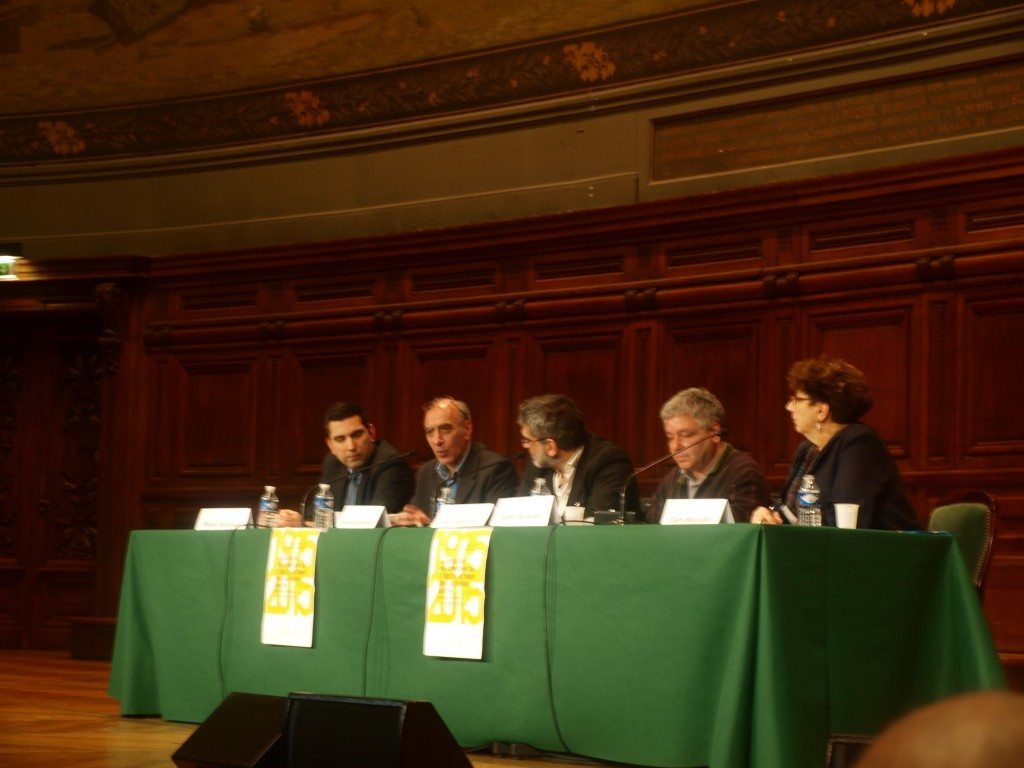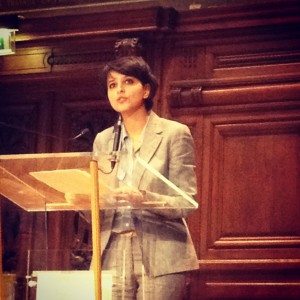Special for the Armenian Weekly
‘France is working to pay off its debt to the Armenians for not having made every effort to save them and prevent their disappearance from the Ottoman Empire between 1918 and 1923.’
PARIS (A.W.)—A three-day academic conference titled “The Genocide of the Armenians of the Ottoman Empire in the Great War” kicked off on March 25 at the Great Amphitheater of La Sorbonne. Historians, researchers, political analysts, and journalists gathered to share their work and reflections on 100 years of research on the Armenian Genocide. The conference was organized by the International Scientific Council (CSI), with the support of “Mission 2015” of the Council of Armenian organizations of France (CCAF) and the Regional Council of Paris and surrounding areas.
“One hundred years ago, one of the most horrifying episodes in the history of Europe and the world was being crafted. The political project of the Committee of Union and Progress, which was aimed at the total extermination of the Armenian people, was about to be put into execution, activating a mass murder, genocide—the first contemporary genocide.” With these words, France’s Minister of Education and Research Najat Vallaud-Belkacem started her speech.
Vallaud-Belkacem expressed her gratitude to historians, and paid tribute to all the intellectuals who lost their lives simply because “they were Armenians.” She spoke about Komitas, “the greatest genius of Armenian music” who “saved from oblivion the most beautiful Armenian folk songs.” She also remembered the poet Daniel Varoujan and the novelist Zabel Yessayan.
Minister Vallaud-Belkacem reminded those present that France publicly recognized the Armenian Genocide through a law passed on Jan. 29, 2001. She spoke about the Armenians who perished during the genocide and shared her thoughts on Hrant Dink, the Agos newspaper editor assassinated in 2007. She also thanked the Turkish intellectuals seated in the amphitheater—among them Ragip Zarakolu and Bursa Ersanli—for their work and presence. She concluded by paying tribute to the history teachers in France, who work every day to make the new generations sensitive, tolerant, and respectful.
Pierre-Cyrille Hautcoeur, the president of l’École des Hautes Etudes en Sciences Sociales (EHESS), was the second speaker on the first day of the conference. He noted that it was not until April 1984 that we witnessed a court session—the Permanent People’s Tribunal in Paris—on the genocide. He reminded attendees that during this session, historian Pierre Vidal-Naquet compared the Armenian Genocide to the Holocaust. During that trial, Vidal-Naquet even used the term “great denial.” It was a great denial not only employed by the Turkish state, but also by its allies, “even by the United Nations,” said Hautcoeur.
Jean-Paul Huchon’s official representative from the Regional Council of Paris told the story of Missak Manouchian, a resistance fighter during World War II. Manouchian was orphaned after 1915, and worked to keep the Armenian culture alive. The representative paid tribute to the 60,000 Armenians who came to Marseille to find a safe haven, and who contributed to the development of France. She announced that the Council will distribute the magazine “Histoire,” which chronicles the history of the Armenian Genocide, to all high schools in Paris and the surrounding areas. In addition, an event is scheduled to take place on May 27 to commemorate the genocide. Taron Margarian, the mayor of Yerevan, will be present.
Vincent Duclert, who emceed the opening of the conference, concluded his remarks with the following words: “France is working to pay off its debt to the Armenians for not having made every effort to save them and prevent their disappearance from the Ottoman Empire between 1918 and 1923.” Duclert was referring to efforts, like the conference, that aim to raise awareness about the Armenian Genocide.
Yves Ternon, an historian and president of the CSI and a member of the Scientific Council of the Shoah Memorial, delivered the keynote address at the opening. He offered a detailed account of the history of the Armenian Genocide. Ternon’s was a powerful speech. He noted, “It becomes more and more obvious that the eruption of war releases moral constraints, transforming individuals, civilians, and the military into murderers.” He explained how the genocide took place, beginning with the putsch of July 1908 and the emergence in the 19th century of nationalists in the Balkans, and ending in 1923. He mentioned the recent massacres of the Yazidis in Sinjar. “The news shows us that sometimes history returns to the scene of a disaster, that the massacres committed yesterday by delirious nationalists are reproduced a century later in the same places, that the monster is back, with another mask, one of fanaticism.” Ternon spoke for an hour, and received a standing ovation.

(L-R) Mikaël Nichanian, Raymond Kévorkian, Gaïdz Minassian, Hamit Bozarslan, and Claire Mouradian (Photo: Fiona Guitard)
The opening ended with a roundtable discussion chaired by Gaïdz Minassian, a political analyst and journalist. He was joined by Claire Mouradian, Mikaël Nichanian, Hamit Bozarslan, and Raymond Kévorkian.
Mouradian said that research about the Armenian Genocide has moved forward in the past 20 years. “It was necessary to reconstruct the facts, which were facing denial,” she said. Now, not only are historians dealing with the research, but also anthropologists, authors, and sociologists. She added that even if the three days of the conference are intense, they are not enough to cover all the research available.
Kévorkian explained that “the ground was cleared collectively these past decades, but there is considerable work to be done.” Kévorkian hopes that new perspectives will soon be explored. “There are interesting perspectives. Micro history is becoming a real important tool,” he said. He gave the example of the brutalization of civilians during war, which can add a different perspective to the study of the Armenian Genocide. He also mentioned another central element that could offer a new angle: the Young Turks’ project of homogenization.
Nichanian insisted that one third of the research presented at the conference is from the specificity of Turkology. He reminded attendees that the conference brought together multi-disciplinarily approaches to research on the genocide.
Bozarslan said that 25 years ago Turkish history could be discussed without even mentioning the genocide of the Armenians. Historians who started to talk about it were marginalized. Turkish national history was not questioned until the 1980’s, he said, and explained the important role Turkish historians could play in Armenian Genocide research.
The conference concluded on Sat., March, 28, at the National Library of France. Videos of the event will soon be released on the CCAF’s “Mission 2015” website.
The post Paris Conference on Genocide Draws Experts from Around the World appeared first on Armenian Weekly.
